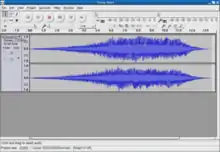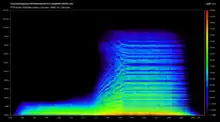Deep Note
The Deep Note is THX's sound trademark, a distinctive synthesized crescendo that glissandos from a relatively narrow frequency spread (about 200–400 Hz) to a broader frequency spread (of about three octaves). It was created by James A. Moorer,[1] a former employee of Lucasfilm's Computer Division in late 1982.[2] The sound is used on trailers for THX-certified movie theaters, home video releases, video games, and in-car entertainment systems.

The Deep Note debuted at the premiere of Star Wars: Episode VI – Return of the Jedi in Los Angeles.[2]
Description
The U.S. trademark registration for the first version of the sound contains this description of it:[3]
The THX logo theme consists of 30 voices over seven measures, starting in a narrow range, 200 to 400 Hz, and slowly diverting to preselected pitches encompassing three octaves. The 30 voices begin at pitches between 200 Hz and 400 Hz and arrive at pre-selected pitches spanning three octaves by the fourth measure. The highest pitch is slightly detuned while there are double the number of voices of the lowest two pitches.

Lucasfilm version (1983–2015)
The first version of the Deep Note called Wings made its debut before the second THX trailer, Broadway, that preceded the premiere showing of Star Wars: Episode VI – Return of the Jedi on May 25, 1983. Two different interpretations of the note ran concurrently with the 1983 version in both the Grand trailer and the 1995 reorchestration of the Cimarron trailer, composed and conducted by the late James Horner. The original Cimarron trailer debuted in May 1988, with the release of Ron Howard’s Willow. The original sound mix of the Cimarron trailer was recalled in 1992, due to complaints from cinema projectionists, by claiming it “blew up cinema speakers,” which led to the use of the more common symphonic mix by James Horner. Users on YouTube found portions of the original mix, when a user found a bootlegged Microcassette recording of the original mix of the trailer. The original trailer has yet to be found in high quality. The Deep Note originally transitioned from a soft to loud intensity, and over the years has been remixed digitally, as new technology developed. In 1992, the Deep Note was registered as a trademark by the United States Patent and Trademark Office.[3] In 1993, the Deep Note was cut short and pitched higher (ending in an E chord rather than a D), to save time for Laserdisc and again in 1995 for VHS. The next trailer, entitled Grand, premiered during the theatrical release of Steven Spielberg's Jurassic Park on June 11, 1993. That logo consists of a Star Wars-esque laser beam cutting to a foggy crimson red background illuminating the screen accompanying with high pitch squealing noises for a few seconds before the corporate logo moves upward in a 90-degree angle in the center of the screen. This trailer, according to The THX Ultimate Demo Disc, was designed by Industrial Light & Magic and sound designed by David Slusser and Marco d'Ambrosio of Skywalker Sound. On July 3, 1996, Tex debuted with the theatrical release of Independence Day. The Deep Note was low-pitched and cut short which is different than other versions. It was later used in the DVD version of the digitally mastered variant of the iconic Broadway trailer in 1997, then later with both the Ziegfeld and Tex Action trailers in 2006. 2001 would be the year when the Cavalcade trailer unveiled to theaters and home media releases based on the trailer seen on the 2000 Ultimate Edition DVD release of the 1991 film Terminator 2: Judgment Day; as seen in prints of many movies. Both that logo and the 2007 Amazing Life trailer had the Deep Note been cut short to the single note (where both sounds stay in one pitch), in favor of other sound effects, Performed by Lost in the Sky. However, in the last mentioned trailers to use the 1983 note, both based on the famous Broadway trailer, the sound was played in full.
The sound is perceived as louder than it actually is; sound designer Gary Rydstrom explains that, "from a technical standpoint, 'Deep Note' just feels loud because it has a spectrum of frequencies that grows from small to large."[2]
Although Moorer had initially claimed that the score consisted of about 20,000 lines of code,[4] he subsequently corrected the statement and elaborated:[5]
The original 30-year-old C program is 325 lines, and the “patch” file for the synthesizer was 298 more lines. I guess it just felt like 20,000 lines when I did it. Given that it was written and debugged in 4 days, I can’t claim the programming chops to make 20,000 lines of working code that quickly. But, to synthesize it in real time, in 1983, took 2 years to design and build a 19” rack full of digital hardware and 200,000 lines of system code to run the synthesizer. All that was already done, so I was building on a large foundation of audio processing horsepower, both hardware and software. Consequently, a mere 325 lines of C code and 298 lines of audio patching setup for the 30 voices was enough to invoke the audio horsepower to make the piece.
Remastered version (2005–present)
In 2005, THX introduced The Science of Sensation trailer, which featured a brand new Deep Note, that sounds similar to the original, although various new voices were overlaid and some voices reach their final pitches before others. This version would be used on all new trailers, except for the Eclipse trailer.
Regenerated version (2015–present)
In April 2015, THX introduced a new trailer called Eclipse, which is accompanied by an updated, more powerful version of the Deep Note, also created by Moorer. It is described as being "intensely more complex, taking the audience on an epic sensory journey unlike anything they've experienced before."[6] This version of the Deep Note was created entirely digitally so it could play on Dolby Digital 7.1 and Dolby Atmos systems, and Moorer created 30-second, 45-second, and 60-second versions of it.[7] Moorer used around eighty voices in the remake, as opposed to thirty in the original 1983 version. In an interview with Yahoo!, Moorer said "I kept thinking: That’s the way I wanted it to sound originally. I think it’s as far as you can take it."[8]
Previous works
Prior to the creation of the Deep Note, several other works made use of similar techniques of frequency spread. A recognized predecessor is a section in the Beatles' 1967 song "A Day in the Life", using a full orchestra. Unlike in the Deep Note, the resolving high chord is never held, but instead brought to a stop. Moorer has admitted that both "A Day in the Life" and a fugue in B minor by Bach were sources of inspiration for the Deep Note.[9]
In their book Analog Days, Trevor Pinch and Frank Trocco say that the track "Spaced", from the 1970 Beaver & Krause album In a Wild Sanctuary, was "copied by a famous Marin County film company" to introduce its film presentations, although they do not identify the company. The authors quote synthesizer builder Tom Oberheim as saying that the original analog form is much richer than the "digital perfection" evident in the sound logo so familiar to cinema-goers.[10]
The 1979 film When a Stranger Calls contains an approximate version of the Deep Note near the 12:30 mark of the film.
The original score

For its 35th anniversary, THX Ltd. released an image of the original 30-voice score, with notes, on their official Facebook page.[11]
In popular culture
British rock band Asia's track "Countdown To Zero" begins with the Deep Note.
In 1992, the 1988 trailer, Cimarron was parodied in the direct to video animated film Tiny Toon Adventures: How I Spent My Vacation with the "THX" name spelled "THUD", including the Lucasfilm Ltd. Sound System” byline also being misspelled to "Mucasfilm Ltd. Sound Systems" and the classic motto "The Audience is Listening" being spoofed "The Audience is Now Deaf". This parody became an internet meme in the 2010s.
In 1994, an episode from The Simpsons titled Burns' Heir, included a parody gag of the THX Deep Note, with the Simpson family in the theater watching "Siskel & Ebert: The Movie", ending with Grandpa Simpson yelling out "Turn it up! TURN IT UP!" THX executives liked the parody so much that the scene was later remade into an actual THX movie trailer, with the scene being redone in a widescreen aspect ratio.[12]
Rapper Dr. Dre was sued in 2000 by Lucasfilm, then-owner of THX, for using an unauthorized cover of Deep Note in the opening track "Lolo (Intro)" on his 1999 album 2001.[13]
KABB-TV Channel 29 in San Antonio, Texas used the Deep Note on its station identification in 1987.[14]
On Neil Cicierega's 2020 mashup album Mouth Dreams, the 15th track "Cannibals" prominently features the Deep Note.
The 1998 PSA from the U.S. Department of Transportation featured the Deep Note towards the end.[15]
References
- "James A. Moorer Personal Website". Retrieved December 3, 2006.
- "About THX". THX Ltd. Retrieved January 4, 2018.
THX Deep Note was composed by Lucasfilm sound engineer Dr. James ‘Andy’ Moorer and was screened at the start of the 1983 premiere of Star Wars: Episode VI – Return of the Jedi.
- "Trademark Applications and Registrations Retrieval (TARR)". United States Patent and Trademark Office. Retrieved December 3, 2006.
- Whitwell, Tom (May 25, 2005). "TINY MUSIC MAKERS: Pt 3: The THX Sound". Music Thing. Retrieved December 3, 2006.
- Kirn, Peter (April 8, 2015). "Q+A: How the THX Deep Note Creator Remade His Iconic Sound". Create Digital Music. Retrieved April 10, 2015.
- "THX Releases Rejuvenated Versions of Iconic 'THX Deep Note' Sound with New 'Eclipse' Trailer" (Press release). THX Ltd. April 3, 2015. Retrieved January 4, 2018.
- Welch, Chris (April 15, 2015). "THX just remade the iconic 'Deep Note' sound you hear before movies". The Verge. Vox Media, Inc. Retrieved March 10, 2016.
Moorer composed 30-, 45-, and 60-second versions of the new Deep Note, but for now THX is only sharing the shortest cut as part of its new 'Eclipse' trailer,…
- Walker, Rob (April 2, 2015). "The 'Star Wars'-Inspired History of the Iconic THX Audio Logo". Yahoo! Finance. Retrieved January 4, 2018.
- Murphy, Mekado (April 17, 2015). "As THX Gets a New Trailer, an Interview With Its Composer". The New York Times. Retrieved January 4, 2018.
- Pinch, Trevor; Trocco, Frank (2002). Analog Days: The Invention and Impact of the Moog Synthesizer. Cambridge, MA: Harvard University Press. p. 128. ISBN 0-674-01617-3.
- "In 35 yrs we have NEVER shown this!". May 25, 2018.
- Mirkin, David. (2004). Commentary for "Burns' Heir", in The Simpsons: The Complete Fifth Season [DVD]. 20th Century Fox.
- Dansby, Andrew (April 21, 2000). "LucasFilm (sic) Taking Dr. Dre to Court". Rolling Stone. Archived from the original on August 4, 2009. Retrieved December 3, 2006.
- https://www.youtube.com/watch?v=1BedYL-4U7A Deep Note on KABB Channel 29 (Late December 1987)
- https://www.youtube.com/watch?v=8AwdKYzKmwk KTVB/NBC commercials, 5/11/1998 (mostly local ads); relevant clip at 5:41.
External links
- Deep Note mp3 at USPTO
- THX official website
- Twenty Thousand Hertz podcast about Deep Note: Part 1 and Part 2